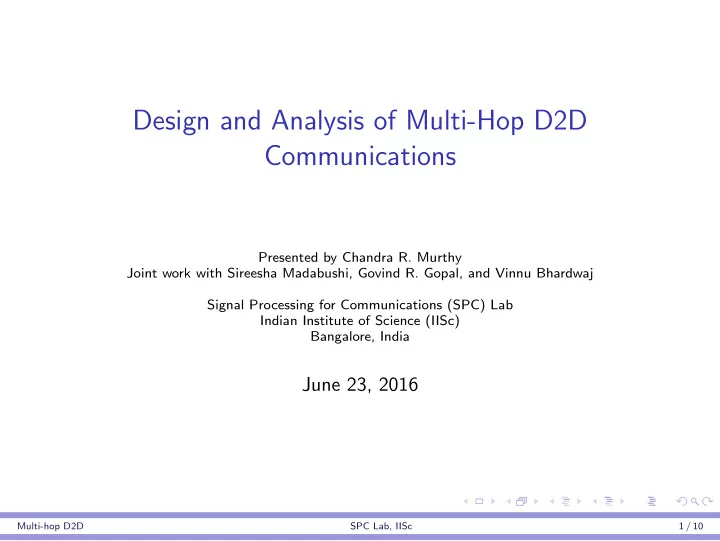

Design and Analysis of Multi-Hop D2D Communications Presented by Chandra R. Murthy Joint work with Sireesha Madabushi, Govind R. Gopal, and Vinnu Bhardwaj Signal Processing for Communications (SPC) Lab Indian Institute of Science (IISc) Bangalore, India June 23, 2016 Multi-hop D2D SPC Lab, IISc 1 / 10
Introduction D2D Communications Direct communication between a pair of devices without going through the base station Major challenges ◮ Interference avoidance/cancellation ◮ Device discovery ◮ Resource management ◮ Mode selection Multi-hop D2D SPC Lab, IISc 2 / 10
Goals of this Study Motivation ◮ Direct path is not always feasible! ◮ But other high rate D2D links may be feasible!! ◮ Is it possible to route data over multiple hops? Aim ◮ Maximize throughput between a source-destination pair under an interference constraint imposed by the cellular network ◮ D2D multi-hop paths are allowed Method Two part approach: 1. Optimal route discovery 2. Sequential link activation and its throughput analysis Multi-hop D2D SPC Lab, IISc 3 / 10
System Model Cellular user ◮ M D2D users and N base stations (BSs) ◮ Uplink-inband D2D Base station ◮ Locations of D2D users and BSs are known, locations of cellular users are unknown D2D destination ◮ Channels undergo path-loss and D2D source Rayleigh fading Interference D2D relay ◮ Only statistical CSI is Cellular/D2D data available/used for routing Figure: Uplink-inband D2D with M = 3 D2D users and N = 1 BS Multi-hop D2D SPC Lab, IISc 4 / 10
The Two Schemes ◮ Fixed rate scheme: all feasible D2D links achieve the same rate ◮ Fixed outage scheme: each D2D link provides its own rate at a given outage probability Multi-hop D2D SPC Lab, IISc 5 / 10
Fixed Rate Scheme: Overview Given: From cellular network ◮ Interference threshold at the BS, γ bs ◮ Interference outage probability, p b : Pr { P int > γ bs } ≤ p b b From D2D network ◮ SINR threshold at D2D Rx, γ th ◮ Data outage probability, p d 2 d : Pr { SINR tr ≤ γ th } ≤ p d 2 d 1. Determine the feasible links according to the constraints above 2. Get the rate matrix and apply routing algorithm 3. For the throughput-optimal route, apply sequential link activation (SLA) scheme for data transmission Multi-hop D2D SPC Lab, IISc 6 / 10
Fixed Outage Scheme: Overview Given: From cellular network, ◮ Interference threshold at the BS, γ bs ◮ Interference outage probability, p b : Pr { P int ≥ γ bs } ≤ p b b From D2D network, ◮ Data outage probability, p d 2 d : Pr { log 2 (1 + SINR tr ) ≤ R tr } ≤ p d 2 d 1. Calculate the highest possible link rates for the data outage probability, p d 2 d 2. Apply Dijkstra’s routing algorithm on the rate matrix 3. For the throughput-optimal route, apply modified sequential link activation (M-SLA) scheme for data transmission Multi-hop D2D SPC Lab, IISc 7 / 10
Comparison of the Schemes Fixed rate Fixed outage same rate with different different rates with All links achieve outage probabilities same outage probability (1 − p out ) Throughput N hops R (1 − p out ) R eff N hops 1 Delay (1 − p out ) R (1 − p out ) R eff Off-diag entries of rate matrix can be zeros are all non-zero more and more links more links start As γ th / p d 2 d increases become infeasible supporting higher rates Table: Different cases for link feasibility analysis during routing and data � − 1 � 1 1 transmission. R = log 2 (1 + γ th ), R eff = R S 1 + . . . + R KD Multi-hop D2D SPC Lab, IISc 8 / 10
Conclusion ◮ Proposed two schemes for D2D communication system design ◮ Found a throughput optimal route with the help of well-known Dijkstra’s algorithm ◮ Obtained expressions for throughput during data transmission Multi-hop D2D SPC Lab, IISc 9 / 10
D2D Mode Selection: An Information Theoretic Perspective ◮ System Model: Single cell with 2 Tx-Rx pairs, simplex communication 1 ◮ Possible modes of operation: 1. Conventional cellular mode 2. MAC-BC cellular mode 3. Dedicated D2D mode 4. Mixed cellular-D2D mode ◮ Goals: 1. Characterize achievable rates under different modes 2. Propose and analyze algorithms for mode selection 3. Handoff from D2D mode to cellular mode and vice versa 4. Extend to K user pairs, account for inter-cell interference, etc . . . 1 Joint work with Ribhu, Kausik Koneripalli, and Vinnu Bhardwaj Multi-hop D2D SPC Lab, IISc 10 / 10
Recommend
More recommend